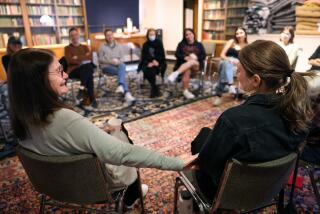James Dean, the epitome of cool
- Share via
James Dean died 55 years ago today, killed in a dramatic car wreck east of Paso Robles that became the stuff of legend. He was 24 when he died, and he inadvertently managed to take a lot of my generation with him, creating a cultural template for the risks we should take with our own lives. Had he lived, he’d be 80 in February.
I was 13 when I first saw him in the movies, and his films offered me an introductory course in how to be a teenage boy in the 1950s. I saw “Rebel Without a Cause” half a dozen times, mostly because I was studying James Dean — his moves, his posture, his way of speaking. I began filching cigarettes from my mother’s purse, practicing how to flip the butt away when I’d smoked it down to a nub, a casually smooth gesture that was, for me and for legions of other aspiring punks, the essence of cool. So completely did I incorporate what I borrowed from Dean that even now, edging toward my own more natural rendezvous with death, I occasionally catch myself in a gesture of his expropriated more than half a century ago.
Dean also taught me, and lots of guys like me, that death was cool. We were a fairly death-soaked generation from the get-go, war babies and Cold War children with an emblematic nuclear mushroom clouding our futures. We were diving under our desks from first grade on, and we became consumers of the apocalypse, frightening ourselves with tales of what might lie ahead in movies like “On the Beach,” or those cheesy sci-fi flicks that populated our dreams with monstrous mutants formed in the fallout from open-air nuclear testing. And there were books too, doomsday scenarios like “A Canticle for Leibowitz” or “Alas, Babylon,” that posited post-apocalyptic visions we read as previews of what was to come.
But Dean made dying a little more palatable. We weren’t the first or the last generation to be “half in love with easeful Death,” but we worked that idea hard and long, with an array of stylistic refinements on the theme that are still sprinkled throughout our cultural iconography.
It was no accident that a raft of rock bands emerging after the assassination of President Kennedy took death as their logo, from the Grateful Dead onward, offering fey and weary salutes to the reaper in music stores festooned with photos of Dean and even Marilyn Monroe — two of the prime young sacrifices on death’s exalted altar. And there would soon be more, because not long after the Who sang “I hope I die before I get old,” Jim Morrison, Janis Joplin, Mama Cass and Jimi Hendrix chalked themselves up on death’s scoreboard, acolytes in Dean’s ministry.
The parade didn’t stop there. The shadow of James Dean has fallen across all of the generations since the 1950s, with dorm rooms still adorned with his image and pop bands still extolling the virtues of death, banging the drum slowly across the genres. Springsteen sang “I wanna die with you Wendy on the streets tonight.” Sid Vicious overdosed and left behind a note: “Please bury me next to my baby in my leather jacket, jeans and motorcycle boots.” Michael Jackson, the King of Pop, danced with the dead in his biggest hit. The current crop of young people is obsessed with zombies and vampires in movies and books. And so it goes.
Dean’s own death was surely a good career move, allowing him to escape the fate of selling reverse mortgages or diabetes treatments to his fellow geriatrics; allowing him, in our minds at least, to fulfill one of the mantras of my youth: “Live fast, die young, and leave a good-looking corpse.
It was all bravado in the face of fear. James Dean died for our sins of life-denial. In “Rebel Without a Cause,” he gave us the template for flaming out. Though his character survived, the central message most of us devotees took from it was that we should take it to the limit and flirt with the edge.
In the famous “chickie run” scene, Jim Stark, the character Dean plays, races toward a cliff, diving from the car just before it plunges to the rocks below. The kid he was running against didn’t get out of his car in time, and so he died. Bummer.
We learned that it was cool to shrug at death, and passed it along. And that may be why the image of James Dean, young and doomed, is everywhere, from Wal-Mart to the Smithsonian, forever encased in youth. It’s impossible to imagine Dean at 80, or even at 50. He is, forever and ever amen, a troubled teen in a red jacket, collar up and shoulders hunched, perfect in his rebellion. Against death, against our fear of it.
Jaime O’Neill is a writer in Northern California.
More to Read
The biggest entertainment stories
Get our big stories about Hollywood, film, television, music, arts, culture and more right in your inbox as soon as they publish.
You may occasionally receive promotional content from the Los Angeles Times.










